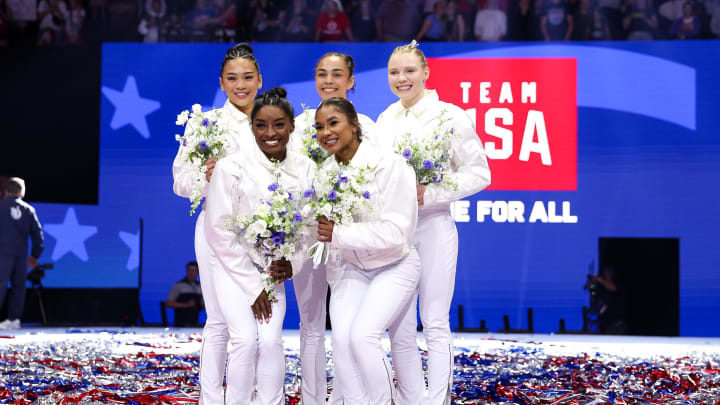After Winning Olympic Gold, Team USA Gymnasts Receive Giant NIL Boost

This week, Team USA women’s gymnastics dominated at the Paris Olympics, taking gold in the team all-around competition and crowning legendary gymnast Simone Biles as the individual all-around champion. During NBC’s live broadcast of the team final, 12.7 million viewers tuned in to watch Team USA compete; however, no U.S. Olympic athlete is compensated purely for their athletic performance on the world’s biggest stage. With a greater viewership than every NBA Finals since 2019, it is shocking that gymnasts will not be paid for their appearance on a national broadcast, but rest assured, these games will create a NIL windfall for all who compete.
While athletes are not directly compensated for participating in the Olympics, medal earners can earn money through the USOPC. Gold medal winners will earn $37,500, silver medal winners will earn $22,500, and bronze medal winners earn $15,000. Many would intuitively think that collegiate athletes, like USA Gymnastics’ Jade Carey, would be barred from this compensation due to NCAA's notorious restrictions on amateur athletes accepting prize money; however, collegiate athletes benefit from an old carveout that allows current NCAA competitors to accept Olympic medal compensation.
In the grand scheme of commercialized athletics, these medal payments are nominal for the athletes competing in front of an audience of tens of millions; it is the NIL windfall that will be coming toward Team USA gymnasts in the months to come that will allow them to cash in on their athletic prowess. Now, in the NIL era, American athletes outside of major leagues (NFL, NBA, MLB, NHL, MLS) are coerced into becoming influencers to earn the money expected from their sport. For example, WNBA all-star Caitlin Clark is the most talked about women’s basketball player but only nets $76,535 in team salary. Clark relies on her independent sponsorship portfolio to make most of her estimated $3,200,000 annual pay.
So, how big has the Olympic boost been for those on Team USA? With social media endorsements making up the lion’s share of athlete influencer engagements, our best proxy is Instagram reach. Looking at Instagram numbers from July 20, a date before the start of the Paris Olympics, we can see astronomical growth from all involved in the team competition.
Gymnastics GOAT Simone Biles increased her following from 7,359,192 to 10,104,407 followers (39.7% increase); former UCLA standout Jordan Chiles went from 571,244 to 991,943 followers (79.7% increase); former Auburn Tiger Suni Lee jumped from 1,674,157 to 2,406,124 followers (45.5% increase); and high school standout Hezly Rivera had the biggest jump going from 103,842 to 277,855 followers (240% increase).
One notable competitor was left off this list: Jade Carey, the only contemporary college athlete on the Team USA women’s gymnastics team. In 2021, changes in NCAA regulations reversed a moratorium on collegiate athletes receiving money from sponsorships and endorsements; all college athletes can now engage in influencer engagements in what is colloquially known as NIL. We will dive deeper to see how much an Olympic boost can benefit a collegiate athlete in this novel environment.
A rising junior at Oregon State, Carey was well accomplished before her trip to this year’s Paris Olympics –– entering this year’s competition holding three world championship golds and a gold medal in the floor exercise from the 2020 Tokyo Olympics. Upon her return to Corvallis, her budgeting may look significantly different.
So, let’s see just how much of a boost Jade will get after the Olympics. On July 20, Jade Carey had a sizeable 344,221 Instagram account following with a 7.42% engagement rate. Things changed drastically after her Olympic performance this past week with Team USA, culminating in a gold medal in the team event and lots of air time on national television. In just a two-week span, Carey has amassed 185,063 new followers, a 56.7% increase in notoriety –– a similar boost to her teammates with the expecption of Rivera. Now armed with roughly 520,291 Instagram followers and an exceptional 19.69% engagement rate, Carey can go to the NIL negotiating table with a lot of ammunition.
What does such an uptick in following and influence mean monetarily? Well, thanks to online influencer calculators like HypeAuditor, we can give some rough justice to finding this answer. The amount of NIL engagements Jade Carey enters into during her 2024-2025 collegiate season is ultimately up to the amount of energy she is willing to expend on influencer obligations. With her fame in the gymnastics community and beyond, there will be no shortage of suitors looking to leverage her marketability. While we can’t determine her yearly earnings because of this variability, we can determine her rate.
According to HypeAuditor, her stats before the Olympics would pinpoint her rate for a branded social media post with large companies between $3,500 - $4,900 per post (an average of $4,200). Using today’s Instagram following and engagement rates, she is estimated to earn between $8,500 – $11,600 per post (an average of $10,050), completely changing the dynamic of any future NIL negotiations.
Put into a different Instagram medium, the trend continues at the same exponential level. Due to the expanded reach and potential virality of reels, influencers can charge brands more for this type of content. Before the Paris Olympics, Carey was estimated to have had a value of $5,200 - $7,200 (an average of $6,000) per branded reel. Unsurprisingly, she can now charge significantly higher rates, this time in the neighborhood of $12,500 - $17,100 (an average of $14,800).
Carey has more than doubled her influencer value in less than two weeks. While these metrics are limited to Instagram engagements, it would naturally follow that her appeal on non-social media campaigns would take a similar hike. While more than doubling her value offline may be ambitious, any tactful agent could certainly make a solid argument for it based on her increase in notoriety.
The $37,500 Gold Medal compensation from the USOPC will be a fraction of what she can command on the NIL market. For Carey, it is estimated that engaging in only three sponsored reels would allow her to surpass her gold medal compensation.
For athletes like Hezly Rivera who have yet to reach collegiate age, the removal of sponsorship restrictions through the new NCAA NIL policy allows her to capitalize on her fame without sacrificing future collegiate eligibility. An athlete’s career is finite and fickle; one slip in practice, and a career can be over. Not having to choose between collegiate competition and lucrative earning years removes a very challenging decision for many Olympic athletes.
The Olympic boost is not solely for gymnasts. Athletes in other sports, specifically highly visible Olympic events like swimming, beach volleyball, and track and field, have leveraged this fame for lucrative endorsement deals for decades. Now, college and high school athletes are able to do the same and maintain their eligibility.
